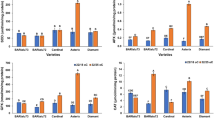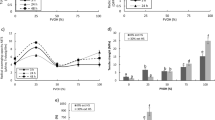Abstract
Rice bran was heated at 120°C for 0 to 30 min to extend the oxidative stability. Also, effects of visible light irradiation on the crude rice bran oil (RBO) from rice bran heated at 120°C for 20 min were studied. As heat treatment time increased from 0 to 30 min, rice bran had significantly high oxidative stability at 40°C for 12 days (p<0.05). Headspace oxygen content in rice bran without heat treatment decreased significantly (p<0.05) whereas those in heat treated rice bran did not change significantly (p>0.05). Results of acid value and conjugated dienoic acid (CDA) confirmed the higher oxidative stability of heat treated rice bran. γ-Oryzanol content was not significantly different among crude RBO during heat treatment and storage (p>0.05). Visible light irradiation caused similar degree of lipid oxidation in crude RBOs from rice bran irrespective of heat stabilization for 48 h, which may be due to the presence of photosensitizers in crude RBO like chlorophylls. This study showed that heat treatment was not effective to enhance the oxidative stability of RBO under visible light irradiation and products containing rice bran should be stored in the dark conditions.
Similar content being viewed by others
References
Chen MH, Bergman CJ. A rapid procedure for analysing rice bran tocopherol, tocotrienol and γ-oryzanol contents. J. Food Comp. Anal. 18: 139–151 (2005)
Lerma-Garcia MJ, Herrero-Martinez JM, Simo-Alfonso EF, Mendonca RB, Ramis-Ramos G. Composition, industrial processing and applications of rice bran γ-oryzanol. Food Chem. 115: 289–404 (2009)
Saunders RM. Rice bran: composition and potential food sources. Food Rev. Inter. 1: 465–495 (1985)
Prabhu AV, Tambe SP, Gandhi Sudhir BNN, Sawant, Jyeshtharaj B, Joshi. Rice bran lipase: Extraction, activity, and stability. Biotechnol. Prog. 15: 1083–1089 (1999)
Baysal T, Demirdoven A. Lipoxygenase in fruits and vegetables: A review. Enz. Micro. Technol. 40: 491–496 (2007)
Hsieh RJ, Kinsella JE. Lipoxygenase-catalyzed oxidation of N-6 and N-3 poly unsaturated fatty acids: relevance to and activity in fish tissue. J. Food Sci. 51: 940–945 (1986)
Anil Kumar HG, Khatoon S, Prabhakar DS, Gopala Krishna AG. Effect of cooking of rice bran on the quality of extracted oil. J. Food Lipids 13: 341–353 (2006)
Rao Lakkakula N, Marybeth Lima, Terry Walker. Rice bran stabilization and rice bran oil extraction using ohmic heating. Bio-Technol. 92:157–161 (2004)
Parbhakar JV, Venkatesh KVL. A simple method for stabilization of rice bran. J. Am. Oil Chem. Soc. 63: 644–646 (1986)
Ramezanzadeh FM, Rao RM, Prinyawiwatkul W, Marshall WE, Windhauser M. Effects of microwave heat, packaging, and storage temperature on fatty acid and proximate compositions in rice bran. J. Agr. Food Chem. 48: 464–467 (2000)
Foote CS. Photosensitized oxidation and singlet oxygen: Consequences in biological systems. pp. 85–133. In: Free Radicals in Biology. Pryor WA (ed). Academic Press, New York, NY, USA (1976)
Min DB, Boff J. Chemistry and reaction of singlet oxygen in foods. Compr. Rev. Food Sci. Food F. 1: 58–72 (2002)
Yang SO, Lee JM, Lee JC, Lee JH. Effects of riboflavinphotosensitization on the formation of volatiles in linoleic acid model systems with sodium azide or D2O. Food Chem. 105: 1375–1381 (2007)
Lee JH, Min DB. Effects of photooxidation and chlorophyll photosensitization on the formation of volatile compounds in lard model systems. Food Sci. Biotechnol. 18: 413–418 (2009)
Lee JH, Min DB. Analysis of volatile compounds from chlorophyll photosensitized linoleic acid by headspace solid-phase microextraction (HS-SPME). Food Sci. Biotechnol. 19: 611–616 (2010)
Lee JH, Decker EA. Effects of metal chelator, sodium azide, and superoxide dismutase (SOD) on the oxidative stability in riboflavin photosensitized O/W emulsion systems. J. Agr. Food Chem. 59: 6271–6276 (2011)
Faria JAF, Mukai MK. Use of gas chromatographic reactor to study lipid photooxidation. J. Am. Oil Chem. Soc. 60: 77–81 (1983)
AOCS. Official Methods and Recommended Practices of the AOCS. Method Ti 1a-64 and Method Da 14–48. American Oil Chemists Society, Champaign, IL, USA (2006)
Mezouari S, Eichner K. Comparative study on the stability of crude and refined rice bran oil during long-term storage at room temperature. Eur. J. Lipid. Sci. Tech. 109: 198–205 (2007)
Kyriakidis NB, Skarkalis P. Fluorescence spectra measurement of olive oil and other vegetable oils. J. AOAC Int. 83: 1435–1439 (2000)
Yang WTS, Lee JH, Min DB. Quenching mechanisms and kinetics of α-tocopherol and β-carotene on the photosensitizing effect of synthetic food colorant FD&C Red No. 3. J. Food Sci. 67: 507–510 (2002)
Huang R, Choe E, Min DM. Effects of riboflavin photosensitized oxidation on the volatile compounds of soymilk. J. Food Sci. 69: 733–738 (2004)
Laguerre M, Lecomte J, Villeneuve P. Evaluation of the ability of antioxidants to counteract lipid oxidation: Existing methods, new trends and challenges. Prog. Lipid Res. 46: 244–282 (2007)
Alamed J, Chaiyasit W, McClements DJ, Decker EA. Relationships between free radical scavenging and antioxidant activity in foods. J Agr. Food Chem. 57: 2969–2976 (2009)
Murty VR, Bhat J, Muniswaran PKA. Hydrolysis of oils by using immobilized lipase enzyme: A review. Biotechnol. Bioprocess Eng. 7: 57–66 (2002)
Shin TS, Godber JS, Martin DE, Wells JH. Hydrolytic stability and changes in E vitamers and oryzanol of extruded rice bran during storage. J. Food Sci. 62:704–728 (1997)
Author information
Authors and Affiliations
Corresponding author
Rights and permissions
About this article
Cite this article
Kim, MJ., Park, J.W., Kim, J.Y. et al. Effects of heat treatment and visible light exposure on the oxidative stability of rice bran and of rice bran oil. Food Sci Biotechnol 22, 1–6 (2013). https://doi.org/10.1007/s10068-013-0205-7
Received:
Revised:
Accepted:
Published:
Issue Date:
DOI: https://doi.org/10.1007/s10068-013-0205-7




